Summer 2023 was eventful for the stretch of avenue du Parc between avenue Fairmount and rue St. Viateur in Montreal's Mile End neighbourhood. Each Thursday between June 1st and July 8th, photographers Fatine-Violette Sabiri and Paras Vijan welcomed visitors into the world of One by Two, their serialised exhibition at Galerie Eli Kerr. These vernissages came to punctuate the lives of many of us in the neighbourhood's creative community; our attention was oriented towards the gallery space and the sidewalk benches that flank the entryway, as we convened in a way that was profound, joyful, and sorely missed once the exhibition closed. That was the experience for the audience — backstage, Sabiri and Vijan worked away diligently and playfully at creating a photography show that, in its durational and evolving nature, put forward a definition of collaboration. Simultaneously, the exhibition rendered visible the parallel mechanisms of friendship and photography, both of which, like collaboration, hinge on time-elapsed.
While the pair of artists describe the similarities of their practices, and that they both produce images within the tradition of conceptual photography, their shared work is not merely convergence. In Sabiri's work, rich textural movement and accentuated colour dynamics play out along softened lines in both her documentary and fashion photography. Hers is a relational photographic self, a personal rapport with the subjects she selects saturates the visual field with warm, proximal familiarity. Sabiri often makes use of humour to facilitate a sense of exhale, or fresh breath. In her 2022 work, Papa, Malika et ma guirlande de pain exhibited in Wink*, a solo-show at Joys in Toronto, Sabiri pulls the fixed moment of a portrait into the present-tense by way of a bread garland that extends from two-dimensionality into three-dimensionality by way of the physical bread strung up in the gallery space. As Sabiri ferries personal iconography back and forth between Casablanca and Montréal, she imbues her photographic work with a flickering temporality, a fluctuating present-tense that is both 'here and there' simultaneously, coated in memory's residue.
Vijan's photographic practice feels inextricable from his experiments with sculptural work, as his images often contain questions of occupied and available space. His photographed subjects inhabit their framed space with varying dynamism, as vectors driving towards an emotional cresting or critical puncture. In his emphasis on the material or technical limits, and questions inherent to photography, Vijan proposes an immanent critique of crisp, perfectly legible documentarian truth. His images are populated, playful, and instinctual; visions from his surroundings collect into an eloquent articulation of presence. As Vijan physically moves between New Delhi and Montréal, so does his body of work, from inside the university, to India, to inside his studio in downtown Montréal. His photos Honestly and Story-teller, exhibited at the Leonard & Bina Ellen Art Gallery, depict two figures, each with their back turned to the camera at varying angles, with flashes of scarlet fabric centered on their bodies, and cellphones in each of their hands. Here, dialogue is both a motif and a verbiage present in the framing, reflecting questions of how photography can be employed as a means of listening beyond the singular moment captured.
One by Two was an ode to friendship and an inquiry into the delineated boundaries of the frame, of the event, and of the exhibition space, but perhaps more enduringly, a means for two photographers to get to know one another and see eye to eye. Here, Sabiri and Vijan share thoughts on the pursuit of objective truth, how collaboration has affected their individual practices, and what performance can offer photography.
[T]here's reality and fiction, and there's objective and subjective. But what if there's some kind of in-between space that gets enacted through hope, which would be photographing something in the hope that it holds a meaning that you can't see in the moment?
Emily Zuberec: I wanted to start with the title of your exhibition from last summer at Galerie Eli Kerr, One by Two. At the time of the exhibition, I was reading The Divine Horsemen by Maya Deren, in which she writes that in Haitian Voudoun, "one and one make three; two and two make five; for the and of the equation are the third and fifth part, respectively, the relationship which makes all the parts meaningful." I detect that there's a similar logic to what came out of your duo-exhibition, and more broadly, in the nature of collaborating?
Fatine-Violette Sabiri: I think maybe to start us off, we can talk about how the title came about. We talked about sharing, making, and blending and eventually we talked about soup. And for a little while the title was supposed to be 'soup'. Because Paras brought up that in India, there's this thing that you can do at the restaurant, which is order a soup and it's called one by two.
Paras Vijan: Let's say you want to share a soup, so you tell the guy one by two and he would bring you the same amount in two different bowls. Just half the portions. In our case, I felt the ingredients were one and two, and the space was sort of the soup bowl.
FVS: I think because we were working with photography, and a photo is a restrained frame, we understood that there's a limit to how we can fully blend our practices if we're going to work with images from our archives.
PV: I like this analogy of like one plus one equals three, because I think that's how it started when we were invited. Eli was like, okay, I like this work from you and I like this work from you. And that was a starting point of one and one. And when I work with Fatine, we take things from the other, we're taking ingredients from the other and trying to make our own adapted version. Liquid is a good word for thinking about soup and this process of addition and choosing works from each other, because liquid can flow, you know, and a solid doesn't really flow. So liquids don't get as stagnant.
FVS: Yeah, the word stagnant really works here, too, because it's a quality I think about a lot in relation to my practice. I have so many photos taken over the span of so many years, how can they not be stagnant? And that takes a fresh pair of eyes to invigorate the images. We have such similar, fixed practices that it was such a challenge to think of how we could make a duo show that wasn't just like a photo show with the documentary images we already had.
PV: I know what you mean, like we've had these photos for some time. They've been sitting and getting more and more stagnant in the bond of pictures, so then what happens when I contaminate my point of view with yours and you contaminate yours with mine? It replenishes a quality in the images.
EZ: So continuing with these ideas of doubling and conjunction, I'm interested in how photography is often a means to collaborate across mediums, but in the case of you both, you're two photographers whose practices are documentarian and often biographical. When I think back on the exhibition, what comes to mind are Brackets and Spread two: Papa de la voiture; Sudhakar, pieces where two of your images were almost stitched side by side, like the pages of an open book facing outwards onto the gallery space. You've already started touching on this, but what is it like working with another photographer in this intimate way, creating physical and psychological proximity between your practices? Closing the gap, per se. Because of course, as I've heard you both say, you can't look through the viewfinder simultaneously.
PV: It's similar to the pulling out of stagnancy, it's like you look at your images next to this other person's image and then, all of a sudden, they start to become relevant. So these images that I might have not used, they're in some sort of a light again, especially with Papa de la voiture; Sudhakar. Fatine has a personal relationship to her picture, but for mine, it's more of a document of being in a remote village and the guy who travels with us, who brings us here. Working with another person and their photos makes a hybrid sort of a meaning between a documentary and personal image. I think the spread of a book form is a very good way of looking at images side by side, because a two side spread is always a diptych and a relationship has to come in. It's some sort of calculation that adds up to three again.
FVS: Yeah, I feel like how was it working with another photographer? I don't know, because I was working with Paras. Here it's important to tell the story of how we came to know each other. I love telling the story. Essentially, we were at Concordia together, in an independent study class, which means that we only met once or twice. So we had one crit together, and Paras showed his work and I instantly felt so jealous. His work was incredible, he was so prolific. I also felt hurt seeing his work because I identified so much with his practice. In my head I thought "I could do what he's doing." So he's my competition, and so I avoided thinking about him for a while. And then three years later Eli put a photo show together and I realized we were going to be in the same photo show. Eli decided it was going to be a two-person show in fact, and that's when I made the switch to thinking of it as an opportunity to pick his brain. I was so curious to know how he thinks of things, how he would put something together. There's an aspect of your practice, Paras, that's more sculptural and in space. You print everything and look at things in a material way which I lack, and so when we had our first studio visit at his studio at Concordia and I was just like, okay, I want to learn from you. And I think that was what informed the working relationship. So that's why I'm like, I don't know if I would work with any other photographer in that way.
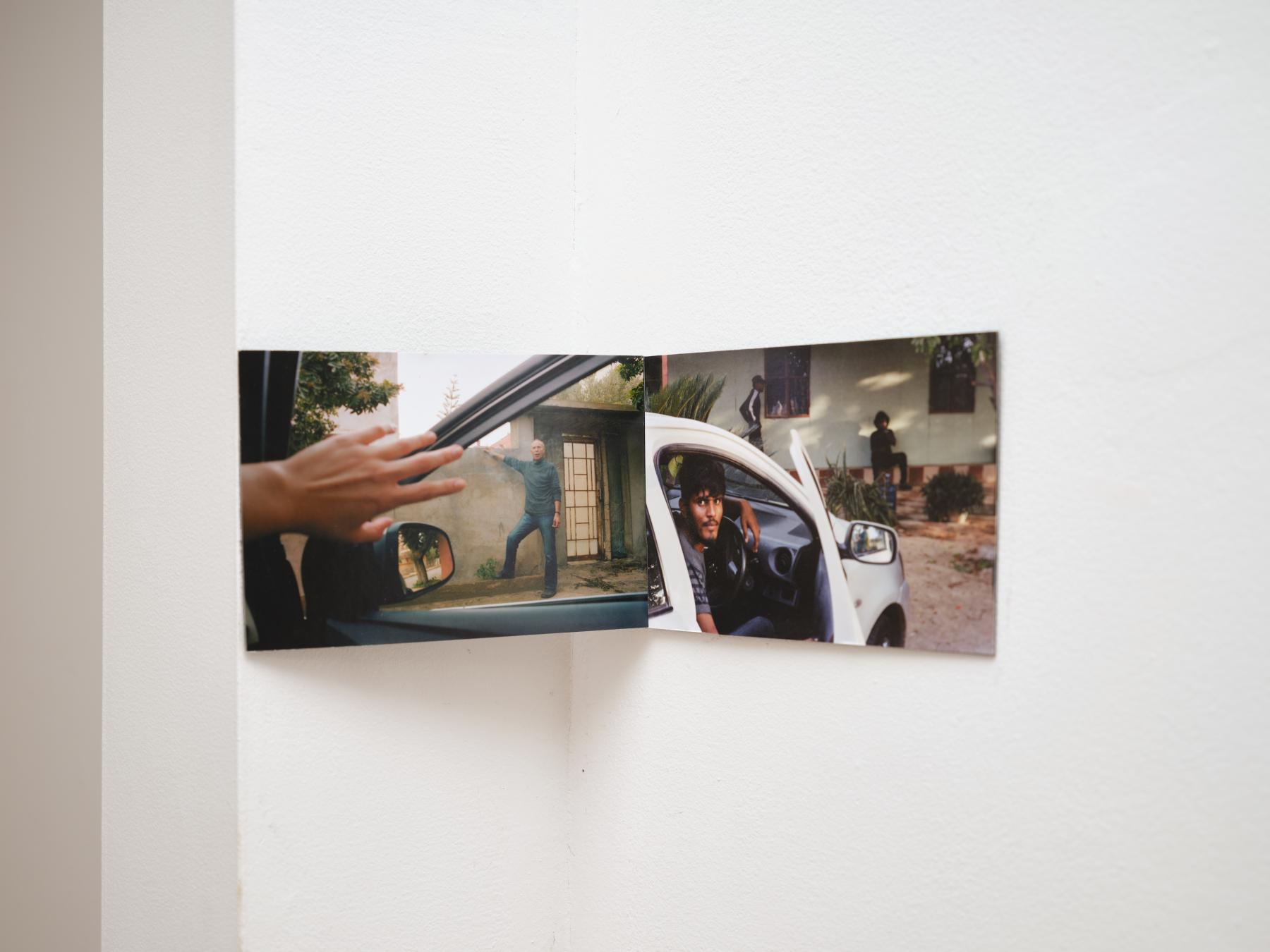
Spread two: Papa de la voiture; Sudhakar, Fatine-Violette Sabiri & Paras Vijan, 2023. Archival inkjet print, 5 x 16”.
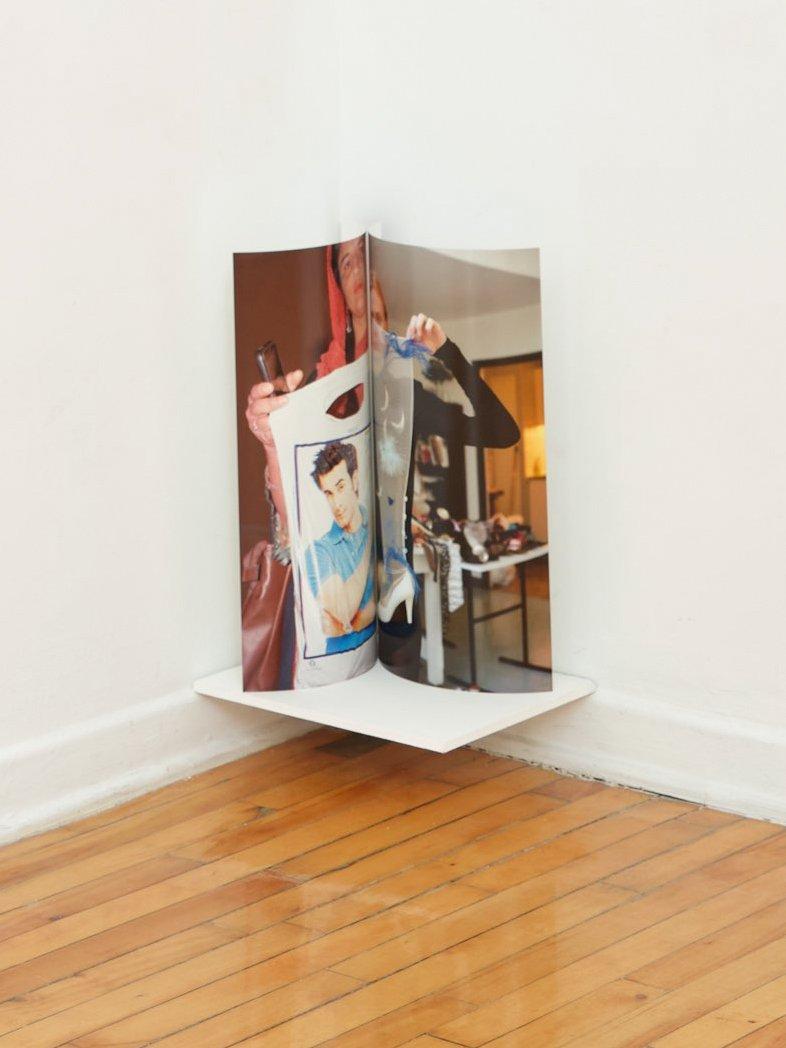
Brackets (Untitled & August’s Boot), Fatine Violette-Sabiri & Paras Vijan, 2023. Archival inkjet prints, 12 x 18”.
EZ: So thinking about that sculptural element, in both of your work you often turn your gaze upon recognizable objects placed in relational tension or technical precarity and they become more opaque, leaving a gap between viewer and author. Objects are both knowable yet ambiguous, a dynamic that to me seems embedded in the materiality of photography - the push and pull between visibility and legibility. Soup as an object, a praxis, and metaphor seems to do this in what you made together.
PV: I think of titles as very dialogical, and how they can take on the role of an object to contrast the image. I enjoy this third meaning that comes out, which occurs in a vacuum, when you take an image and then you take your title for it and they're completely not pointing to the same thing. It opens up, or breaks down, this image to text relationship. I think the relationship I'm talking about here is like "A" for "Apple," a literal image to text association that's very complementary. How do you go beyond it? I like this sort of confusing information given with an image, it brings the image to a different thinking place, a third place, which is somewhere in the air. I feel like it makes this third image in the mind's eye of the viewer. At least it does that for me.
FVS: I think for me, what often ends up happening is that I try to remember the personal aspect of the work, or of the object. And in titling works, or in choosing what to photograph, to remember that it always has to be about something that is true to me. Like Ode to Sudek, that's a conversation we had. We share a love for that photographer, and someone seeing that image might not understand what's going on and they have to have a conversation with us to find out. It's in a secret hope that the work is going to involve participation from the audience by way of curiosity. Those are conversations I want to be having with people and I feel like it's like a secret way to talk to people when objects are unclear and viewers have to ask "why is that like that?" And then I get to tell the story.
PV: I think it's also with photographs that there's a question of where and when, the time and space, that's tied to each image. Irrespective of how it's photographed or where it's photographed, there's always some sort of a story behind it. We know there's a documentary impulse rooted in photography. And, academically speaking, it's as accurate as you can go in the rendition of reality. It's never real-time reality, but it's the closest you can get to it.
FVS: Thinking about the intuition behind taking certain pictures, there's this whole category that are simply scenes you find beautiful, or moments when the lighting was nice, or a flower that looks like a tableau, like a painting, and those are the works that are the hardest to show. It feels so outdated to want to show something beautiful, but the impulse to take a beautiful photo is constant. It's like when I was in Marseille with Eli for Art-o-rama, two of the images I showed were an image of a rooster and an image of a bowl of fruit, and in that context it was really hard to talk about my work. Because it was a fair, everyone's theorizing about the work they saw, but these were images of two objects that were beautiful to me. I was like, simply, this rooster wasn't moving, so I went and took a photo of it because it was available to me. The light in there was beautiful, and that's that.
EZ: So as a follow-up question: it's like these objects act as a flare up through which large scale thematics can pop through, like a portal in the unit of the image. All objects and images then have double meanings, depending on who looks and with what in mind. It can be so frustrating to try and capture a theory or experience as a whole, but then an object or an image becomes an access point into a larger meaning. But then also, if you want to find a vehicle for a concept in an image or object, you will find it.
FVS: I think that's why it's easier to show photographs of objects, because the opposite would be the images in our exhibition, which was predominantly photos of people we know and love, or scenes of strangers, documentary-type images. It seems like the only available interpretation there is the actual story, falling under the umbrella of personal narrative. Whereas when you photograph an object, it can become a source of such plural meaning, which is so much more relatable to a variety of people. There's this funny dance I find myself doing more and more as I show more work, which is that I'll think of a photo I'd like to show, sometimes it's a photo that has a meaning that's interesting and can be theorized, or has a lot to bring conceptually to a context of photos, but then sometimes I'm stuck because it's just a photo that I really love, when the light was perfect and I want to show it simply for that reason. So I'll do this justifying dance of "Okay, what is this photo? This is a photo of a cow. What about? What does it make me think of next? Oh, it makes me think of this, and then what does that make me think of? It makes me think of that, and what does that make me think of that?" I arrive at an access point into theorizing about it. I see if that theory or concept next to my image still has some relevant meaning. But it's funny because you can do that with anything, and it upsets me in ways.
PV: Because we're talking about documentary and legibility, I think imagination is also another way of getting closer to the thing in the image. I immediately think of this photograph by Jeff Wall, which is called A man with a rifle. It's of a guy in the street who's ducking behind a car and who's pretending to hold a gun. He's just posturing as if he has a gun and he's shooting on the other side of the car. It's our imagination. Wall doesn't even need to title the image as he did, we know what that posture is and it's immediately recognizable. It brings us immediately to the idea of something that is not even in the photograph. And in that case, the crucial object is withheld.
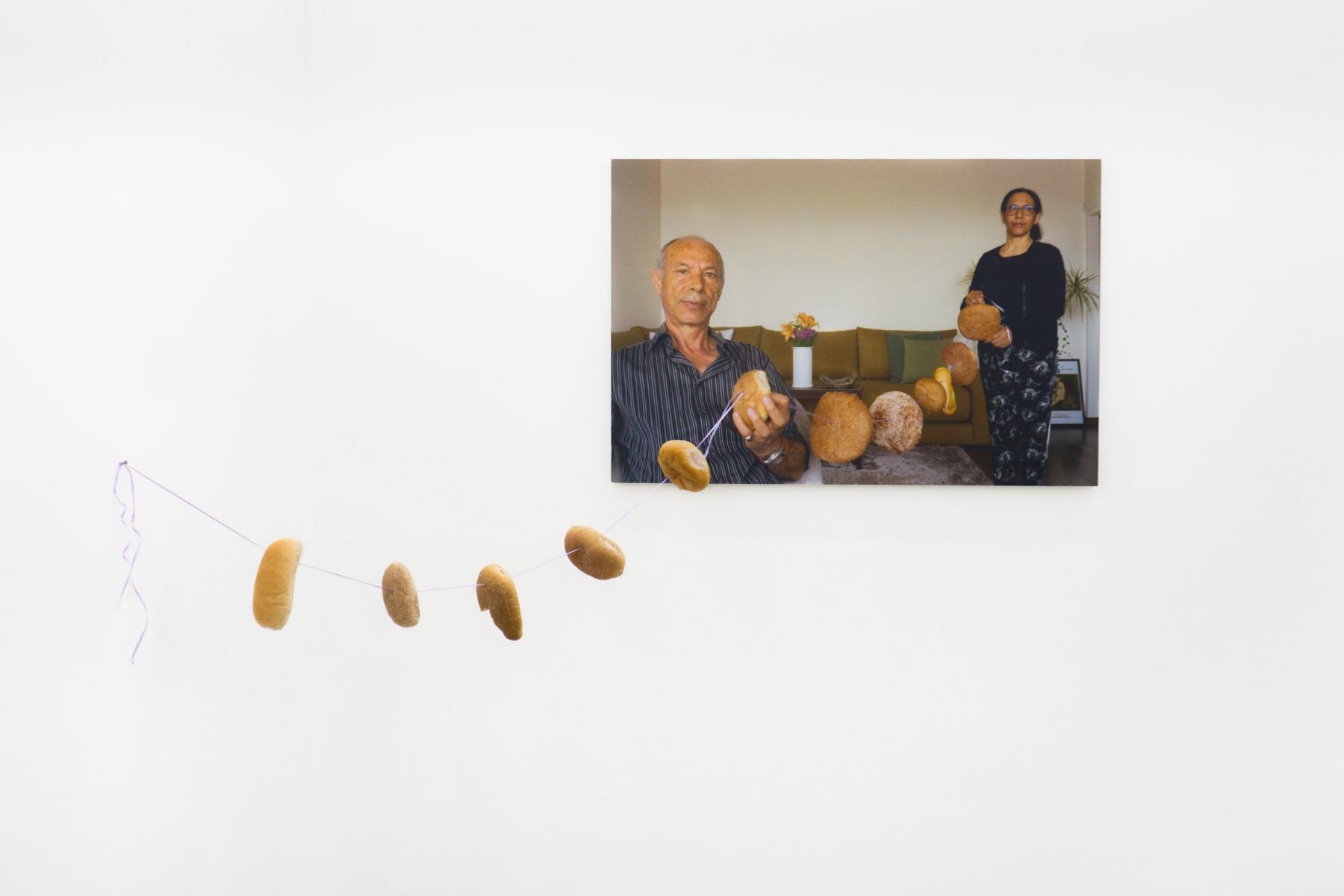
Papa, Malika et ma guirlande de pain, Fatine-Violette Sabiri, 2022. Polypropylene banner on melamine, acrylic paint, curling ribbon, homemade and store-bought breads.Caption
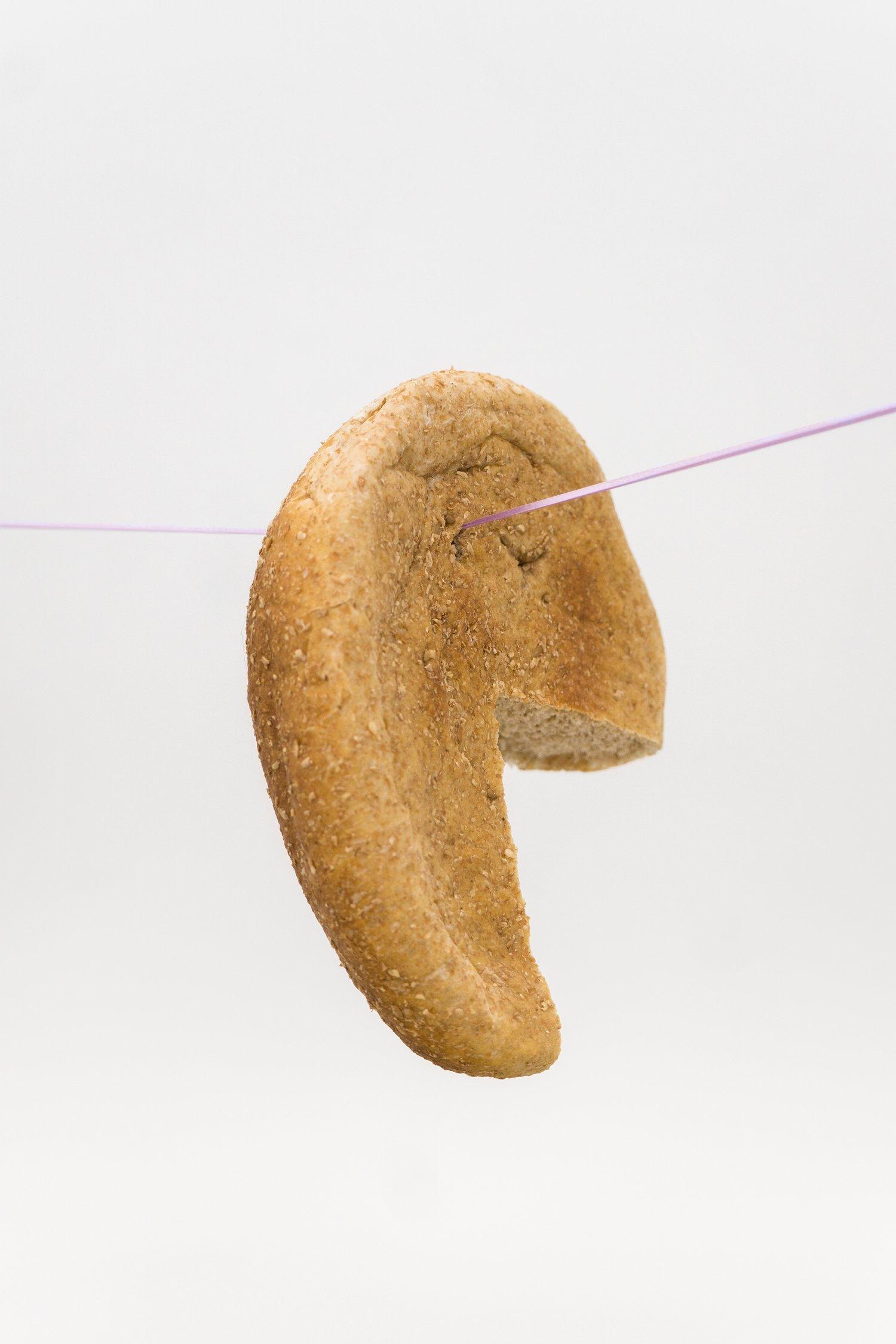
(Detail) Papa, Malika et ma guirlande de pain, Fatine-Violette Sabiri, 2022. Polypropylene banner on melamine, acrylic paint, curling ribbon, homemade and store-bought breads.Caption
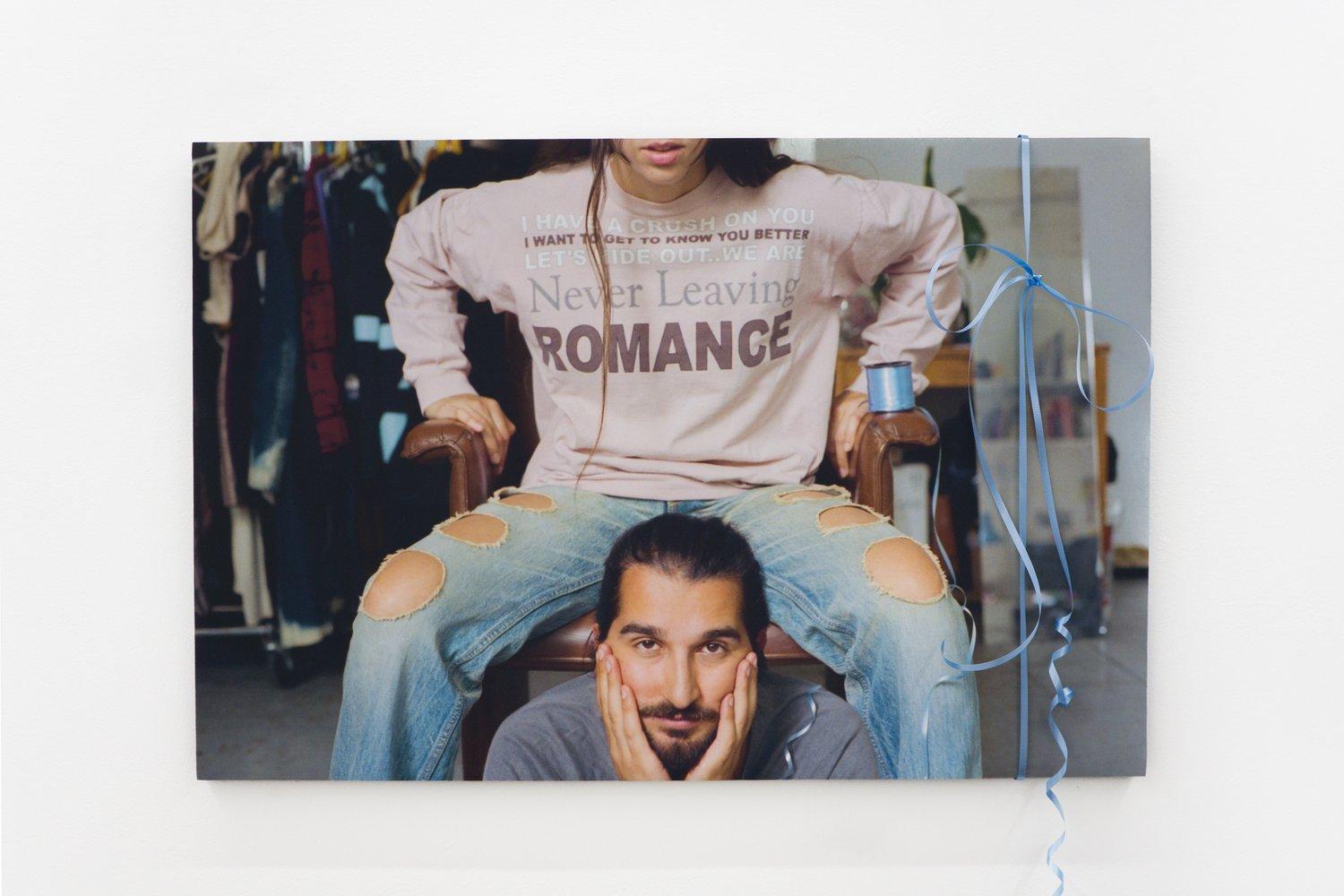
Shahan a trouvé ce chandail parfait pour moi, 2022 Polypropylene banner on melamine, acrylic paint, curling ribbon, 16 x 24”
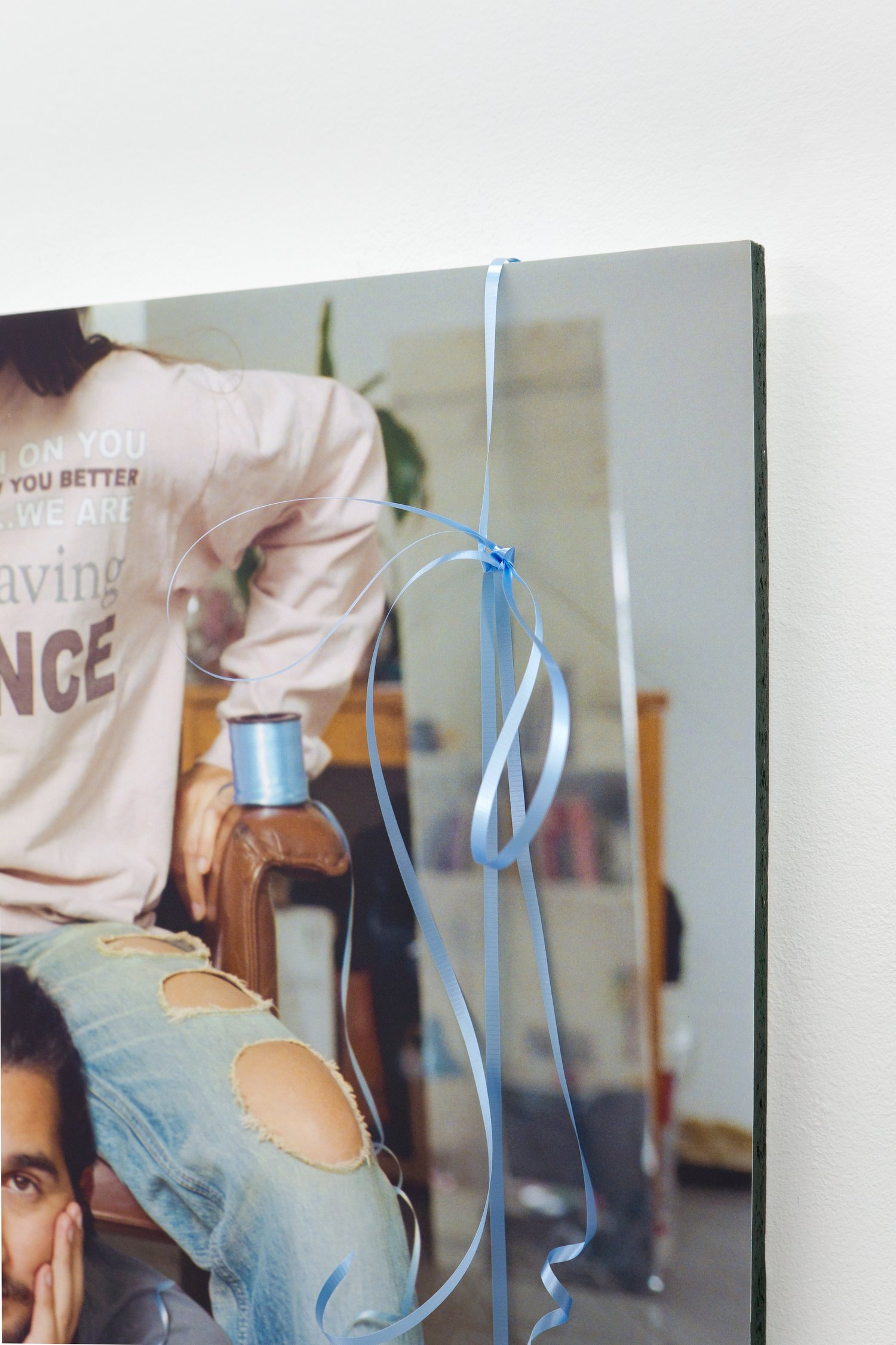
(Detail) Shahan a trouvé ce chandail parfait pour moi, 2022 Polypropylene banner on melamine, acrylic paint, curling ribbon, 16 x 24”
EZ: So pivoting slightly, you both work from your personal archives, which consists of images made in Morocco, for you Fatine, and India for you, Paras, as well as images from Québec. Perspective is what you have as photographers, both relating to your eye and the quality of vision, but also your physical position in space either looking to Morocco and India from Canada, or the reverse. There's a perpetually in flux "here and there" defined by a method where you work alongside memory, situatedness, and in what direction you focus your attention. I'm interested in how "here and there" function as unfixed and shifting operatives in your work.
FVS: I don't know if it's like this for you, Paras, but it's something I'm trying to work at dismantling more and more, because what fueled my photo practice for the longest time was an obsession with the past, with the archive of the past, obsession with how I'm going to look back on the past in the future, so essentially it's an obsession with time. And to me, this here and there, unfortunately, is always tied with past and present. Because I grew up in Morocco and I left when I was young, it's always a place of nostalgia, even if it's the place where I currently am. It's the place of my childhood. And there is always the past and here is always present, and Morocco is always the past and Québec is always present. When I go back and I take photos, I'm chasing something from the past, or I'm worried about this becoming too past-tense and I'm trying to make sure I secure images of it for the future. That relationship of here and there is linked to time for me. And in working with Paras on the show, I felt like I was working with someone who has this double life as well, of here and there. And it made Morocco, and images of Morocco, seep into the present by virtue of someone seeing them and relating to them, and by all our discussions about family, all our discussions about not calling enough and not physically being there.
PV: I feel like this concept of here and there functions, as a photographer, being somewhere and leaving that place, doing something here and taking it there, as a removal of images, yes, but also myself from point A to point B. When I'm in point B, I'm able to reflect on what I have done in point A, and then what point A actually is can be fully grasped when I'm in point B, because then you're exposed to these two different places and you experience things differently in relation, or, you establish what the other is in relation to movement from here to there. So, like you said, they're very interchangeable. We take pictures in our countries and we come here and then we're able to have some sort of a read on it from a distant point of view. But not even just pictures, let's talk about relations, you know? I come here and then I experience a whole different way of socializing with the world, like I think also the lifestyles that we lead in these two places are very different. The meaning of the things that we bring with us shifts from Morocco to Canada, or India to Canada, like that thing represents something different now. It gets exoticized in a way. It also opens up this other door to the question who I am, what's my positionality?
FVS: Yeah, it's this particular situation that I think we share that I always refer to as the 360 of my life, that there's not many people who know me 360. There's people who know me 180, you know. But then there's this whole other half. And the fact of the matter is that these two parts are completely separated, the only overlap is myself. So the images taken in one place and brought to the other become objects and they take on a whole other meaning.
PV: I have a question for you, Fatine. Do you feel like you have some sort of an aerial bird's eye view when you're looking at those works from Morocco, from a distance? That you can see an overall picture of what was going on when you were inside this, I dunno, circle. And now you're outside of the circle and you look at the circle and you can tell it's actually maybe not a perfect circle, maybe it has bends and different ellipses. You know what I mean? Like when you bring things from there to here, what changes?
FVS: It's funny because you're looking at something from a distance, so yes, you do have that bird's eye view, as you say. But I think it's something that I catch myself being wary of. I was once at this Cinema Politica screening of that movie Whose Streets? about the protests in Ferguson, and I remember the director saying something that really stuck with me. She was like you know, I'm a Black woman but I'm not part of the community in Ferguson, but I wanted to make a documentary about it. And you think you're part of a movement or community because you align with people, but the minute you hold a camera to an event, or a subject, the minute you're trying to document, it means that you believe you have a critical perspective on a thing and it separates you from the event or subject, and that's something you need to keep in mind. I think when I'm in Morocco and I'm taking photos, I'm doing something lovingly, but when I come back here and I look at the images, the rapport changes. The images become things that I look at, you know? They become representative of objects I realize I need to keep as true, instead of moments that I lived.
PV: Yeah they do become objects which you can look at from many different sides. Then when you bring the object of a photograph from one place to the other and you try to explain to someone who's not from there, you talk about all these different things that are surrounding the image, cultural connotations. I think that's how we make an understanding of this other place with images.
FVS: Okay, a question for you, Paras. Do you ever show your photos of India to your family members in India?
PV: No, no. They would see things that I've done here, documentation of an art show for example.
FVS: Yeah, I'm asking you this because the second I show a photo I took in Morocco to one of my family members in Morocco, what they think to say is either, why would you photograph that street? It looks disgusting. The walls in that room are not well painted, we need to renovate that room, don't show this to your friends, it's embarrassing. Or, oh my God, you took a photo of that funny thing that's in every corner store? They don't think of my photos as beautiful, or as interesting, because they're in that world all the time, you know? The only reason I can take that kind of photo there is because I live here. What I focus on are nostalgic scenes, like an amulet, or a remnant of the past that I hold dear because I'm no longer there. If I was still living there, I would never think of taking the photos I take.
PV: You're basically defining how my mother is, like, oh, don't take a photo of me when I'm not ready. Like we want everything to have this idea of beauty attached to it when you're there.
EZ: Which goes with what you were saying earlier, Paras, about the idea of the camera as being closets in proximity to objective truth. But that seems to, at least partly, have gone out the window. So then there's a tension of truth as you use a machine to make literal imprints of the world, which is so layered and coded. I actually had a question about truth, which is that to me, I think about truth as either being by revelation (experiential) or verification (evidence). How do you both think about the tension of truth in your works? The implicit doubling of reality in making an image seems to complicate truth, in some ways.
FVS: For our exhibition we were talking about truth a lot, and in our practices separately, we're obsessed with this notion of truth and the tension with fake, or a backstage and front stage dichotomy. All those mechanisms which are quintessentially the issues of photography as a whole, you know, we still can't get over them. What I've been thinking about more and more lately is like, okay, there's reality and fiction, and there's objective and subjective, but what if there's some kind of in-between space that gets enacted through hope, which would be photographing something in the hope that it holds a meaning that you can't see in the moment? It's like you're taking a photo of something that's intuitive, you know, you're photographing not because it's true or because you want it to be a representation of truth, but because you hope to find meaning in it sometime in the future. And I think because I've been working on this book made up of photos from my last ten years, now I look at certain images that I took eight years ago or something and I realize how they're actually prophetic. That's a place I want to stay for a little bit when it comes to photography, no longer in a mode of questioning truth versus fake, or the boundaries between front stage and backstage, but in the magic of the whole thing. The hope that in due time something else will be revealed, other than the photo itself physically being developed. There is going to be more than just the chemistry of it.
PV: I think especially with a photo book, it's like, yes, there's fact, yes, there's fiction, and both those things are always going to be in a photo. But when you put them together, it's an exercise in world-building. It's like one plus one equals another world. A world that exists in photographs.
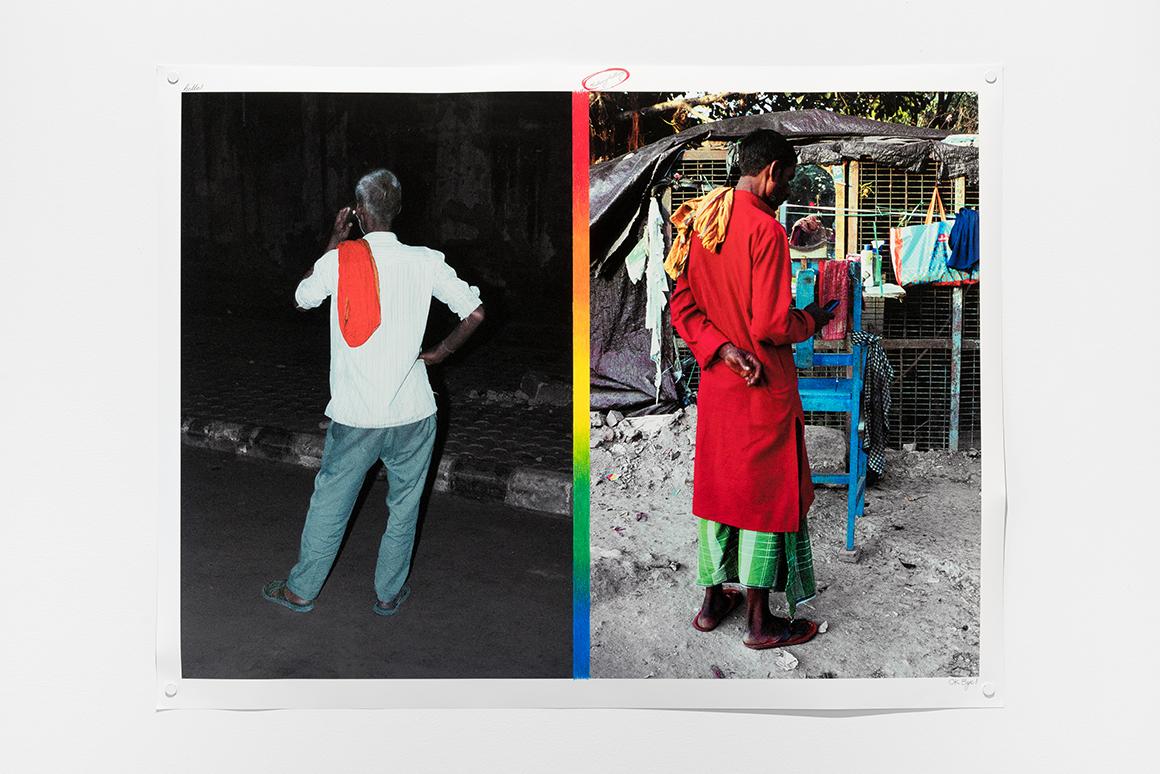
Honestly and Storyteller, Paras Vijan, photographed by Jean-Michael Seminaro, 2023. Archival inkjet print.
EZ: So another book I read around the same time as your exhibition was What Was I Thinking? by Jalal Toufic. In the essay "Labyrinth," Toufic supplements the Encyclopedia Britannica definition for labyrinth by inserting a missing distinction between "maze" and "labyrinth". As he writes "mazes can both be "complex branching multicursal puzzle[s] with choices of path and direction, while a unicursal labyrinth has only a single path to the center. A labyrinth in this sense has an unambiguous route to the center and back and is not difficult to navigate." While Toufic also distinguishes between mazes and labyrinths, he "reserve[s] 'maze' for worldly configurations and 'labyrinth' for unworldly, unnatural spaces and times.". There's something about the never-ending pursuit of realism, or capturing something in an image, and what one encounters on that path, especially when entering territory with another artist whose tools are very similar to yours.
FVS: I love that distinction, and it makes me think about what we said earlier, about the way we work together. We found ourselves in the midst of a maze with a million routes we could take, and we were like okay, the challenge is to make a labyrinth out of this maze. A lot of the process of working together was about restraint, and about holding back. Of putting up walls in the maze to guide us towards something, and like, in real-time cutting off some of the possible routes. Which was ultimately generative.
PV: Yeah it was episodic, with the exhibition unfolding over and over and people had to navigate the labyrinth of progression.
FVS: Because it had to be a logical progression because every take on the show, we would keep at least one work from the previous week. There was no week that we fully started over.
PV: Yeah, the presence of the previous week was always felt, like marks along the path.
EZ: Yeah, it's important to mention that your exhibition was serialized. You changed around once a week and it seems to me to have complicated the idea of one vernissage, one exhibition. Like working in this indexical way seems to have disrupted singularity. And so viewers were challenged with a different version of 'newness' upon each visit. I was looking back over the documentation this morning, and I hadn't really noticed before, but instead of labelling them "week 1, week 2, etc" you called them "take 1, take 2 etc". I'm curious about how this process perhaps added a complexity to the way duration, or time-elapsing, operates in your practices?
FVS: I think the reason it happened that way is because time was of the essence, but it's also such a photographic impulse. You take many photos of one thing and then you don't know which one you want to pick. You're always told one image is more impactful or something, and then sometimes you go for a diptych or a triptych, but most of the time you want to pick the right image, which can be so hard. I think we were trying to avoid picking only one image, so extending beyond one moment.
PV: I often saw it as the next episode of a show, or from a viewer's point of view, I engaged as if there's a new episode coming up next week. And I want to binge it, but I can't. We stretched and paused time in a way that doesn't happen in our normal working rhythms.
EZ: This leads me to a question about artistic closure, which seems like a difficult task of tidy completion. How do projects you work on, whether with artists in other disciplines, individually, or with other photographers spill over after the end date? Both of your works have such flickering engagements with temporality, do you feel like the exhibitions you work on are conclusive or inconclusive?
FVS: Thematically, there are always ideas that are spilling out, or always on my mind. And then there's also things that I feel like I've already done I don't want to dabble in again. And it's a very clear line. Like, no, I can't do this kind of work about that subject again. But then there's conversations that Paras and I had during the show that we want to keep having, about how we want to continue on certain themes together. I remember putting up the last iteration of the show, which consisted of all the works that we had shown during the six weeks, and thinking that that was the show I'd been wanting to make since the beginning. Like this was the satisfaction I want to feel after doing thorough work, to put something up and feel some closure. But then that feeling is also from getting to know Paras. And now that we know each other, our conversations are spilling over.
PV: I think of the spreads that we made. And how at some point we talked about doing a book together, we also had the idea of going on a road trip together, and I feel like those are the ways this is going to spill over into the future. Like to that question of okay, what's happening next? From the fragments of what we did there something will come into their own bodies of work. I feel like in the show we made a good index of all the different possibilities that we can expand on. Like now that we've come back from the labyrinth we know what's at what turn, we know how to orient ourselves a bit better.
FVS: Honestly, we can talk about art as much as we want, but at the end of the day, we also just are really obsessed with our relationship. I think that that's what spills over. That's what spills over into my own personal work, the things that are still on my mind when the show's over or when I'm done shooting. Art is simply just real life. Like we've said, you can theorize as much as you want, but it's still just a response to what you're living through and we became friends and I could make so much work about that, now.
PV: Yeah, the meta aspect of our show being self-referential to us in the way that as much as it was a practice in exhibition building, it was also a practice in relation building.
EZ: So that goes into my next question, which is what kind of residue is left on your practice after being attuned to each other so creatively? And how do you both now orient yourselves towards the thinking and images you produced almost six months ago?
PV: I feel like it goes back to the first analogy of one and one is three. It's like we both have our own practices, and then when we're together we have a separate practice that neither one of us has in our own practice. It becomes this different collective practice and can only exist when we're working together, but otherwise it doesn't really function when we're alone.
FVS: Yeah, there's a space in which I can only operate with you, and there's ideas that I wouldn't be interested in exploring in my own work. In terms of what's left, I would say it's funny because earlier I was trying to make a case for beauty, and I still stand behind it. But I also think that in Paras's work I see really often an urgency, like this thing is happening and I need to photograph it because it's a singular moment. Whereas my approach is more tuned into a beautiful object, or the light, or like this is someone I love, you know? There's a slowness and a pause in my work and for you, Paras, I think you sometimes have that as well. But what sticks to me about your work, and what I want to emulate more, is a sense of 'to hell with the framing', or whatever. Your dynamism is really what sticks to me.
PV: I would like my work to be a little subtle sometimes and maybe a little more thought out, to take time with it, like you do, Fatine. I come from a street photography inclination, a photojournalist inclination, because initially when I started doing photography, I wanted to become a photojournalist, I wanted to be in tough places and come back with these pictures with this sense of aggressive urgency. I guess that's where this sort of quick, quick, quick work came from.
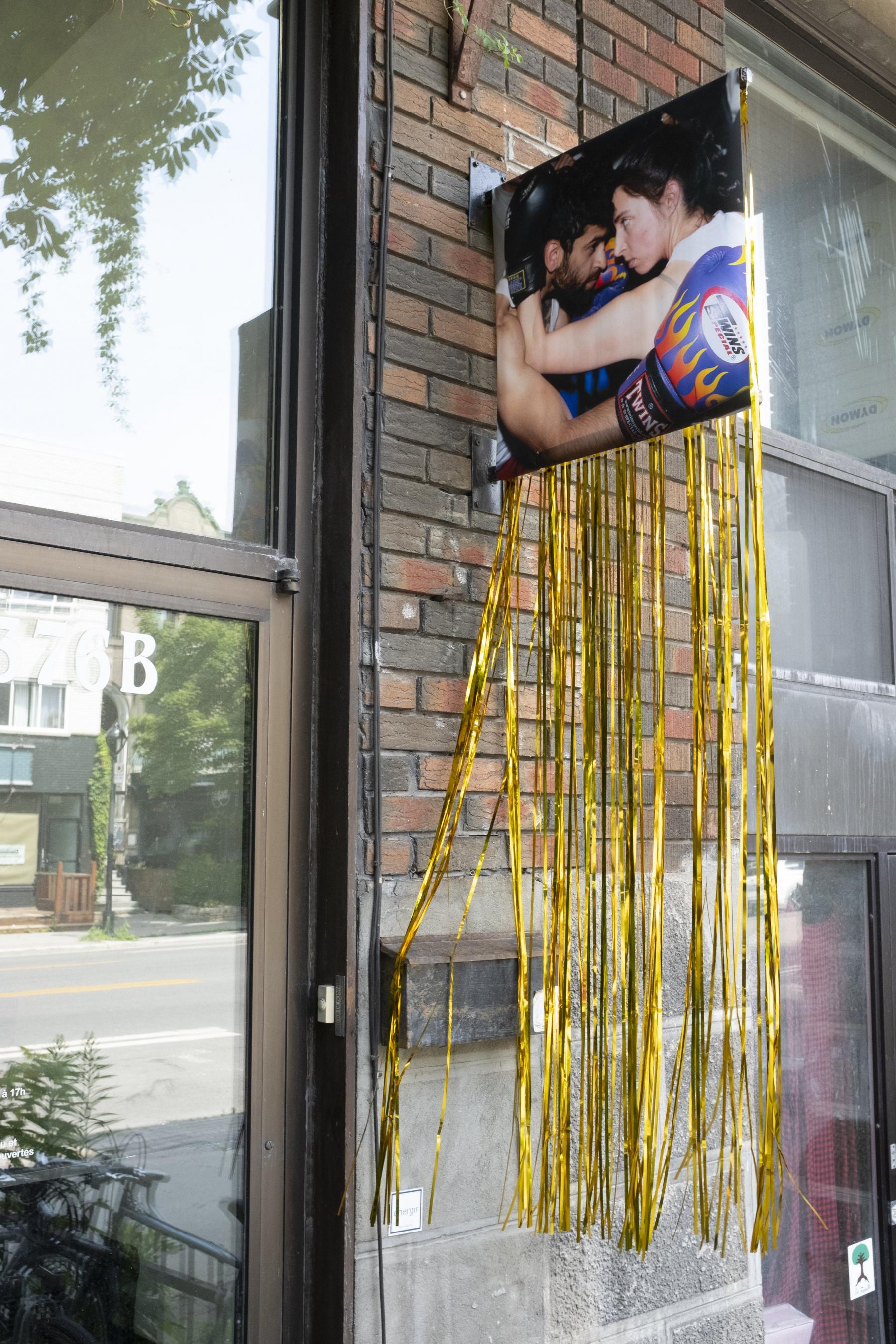
The Main Event by Pablo, Performance by Fatine Violette-Sabiri & Paras Vijan, photographed by Pablo Peréz-Diaz, 2023. Inkjet print on textile.
EZ: Performance seems totally integral to both of your work. Paras, I think of your piece Looking at photographs, a video that shows you working, sorting photographs; Fatine, self-portraiture features heavily in your larger body of work, but what comes to mind is Jalouse, a portrait of your Olympus. I then think of Ode to Sudek, an image you made together during the exhibition, that shows either an installation or de-installation, or alternatively, the way the intimate worlds of photographs are constructed, like those of Josef Sudek, and so are gallery spaces and the events they hold within them. A reflexivity towards the photographic act and the inherent performativity of photography seem to be engines of inspiration for you both.
PV: It was already in the conversation that we were going to document that piece and we were thinking of this photography exhibition, and documenting a photography exhibition. So playing with photography exhibition; exhibition of photography. It sounds like a play on words but it was a way to transform what we were doing through performativity.
FVS: Yeah, I think for Ode to Sudek it also comes from an irresistible urge. Like, we're photographers, we made this cultural thing, but we also need to photograph it. Like okay, this exhibition is going to be documented, but as photographers, we want a photograph not a documentation, a photograph of this sculpture we made. You know, like, arroseur arrosé. I don't know how to translate that. We had these conversations about Sudek and his methods of photographing still life, and we're going to just apply it because that's something we have in common and we were getting to know each other. So let's use what we have in common to start a conversation. And I knew that you were also taking self-portraits, Paras, so I was like we need to both be in that image, because the show is about us in dialogue, and it's also about the mechanisms of making a show. And those mechanisms were in the photo.
PV: Yeah, we're not really artists, we're just acting as artists.
FVS: For me, this photographic self-reflexivity question comes out of a weird insecurity of, I'm constantly documenting all of your asses’ lives, who's going to document me inside of my life? And so that's why self-portrait is important to me, I'm doing it for thorough documentation. I need to find myself in my memories when I look back, I need to see myself as well. I think back to even in my undergrad, when I was doing a lot of fabric dyeing, I would take photos of myself dying my fabric, just to remember that that's a thing I used to know how to do, like, that's a process I used to be engaged in.
PV: That's also a performance, because the thing is done, you know? Performing or pretending, as if making it in present tense. That's really interesting, the whole staging of it. And for me, before the show, things were more improvised, like in the video piece that you spoke of, but during and after the show, calculated performativity and performative aspects really grew into something that I really wanted to act upon, because I like this idea of make believe.
FVS: Yes! And I do think there's such a discourse about like the truth and like the absence of truth, or like subjectivity, like photography is evil, there's a make-believe aspect to it or something. But even if it is make-believe, it's simply representational. In that way, it's almost closer to painting, like you said earlier, Paras.
PV: Yeah, like the Roger Fenton photograph Valley of the Shadow of Death. Fenton took two pictures: one of the pictures is the documentary shot, as is. And he took a second picture where he's moved these cannonballs into the middle of the road to emphasize how big of an event the war is. I think enacting things makes a more impactful visual experience. I think it is important to sometimes exaggerate. Introducing performative elements can do this exaggeration.
FVS: Nothing comes as close to the feeling itself, as we experience it, and sometimes when you exaggerate things, the person on the receiving end can get closer to your feeling.
PV: Sometimes the imaginary can point to a more real aspect of living than what reality can, it's hidden in plain sight.